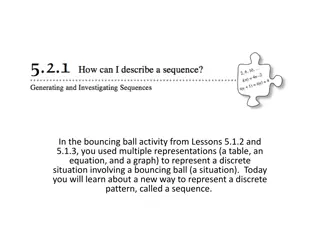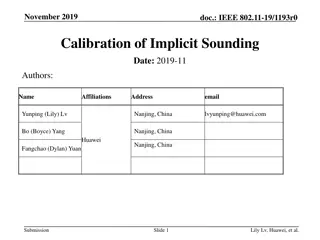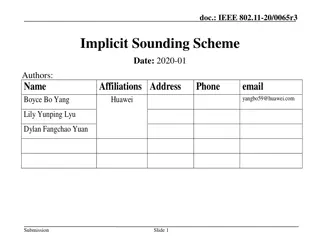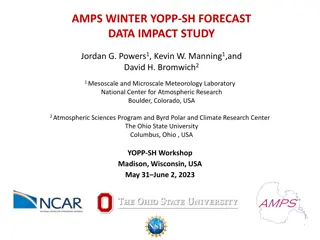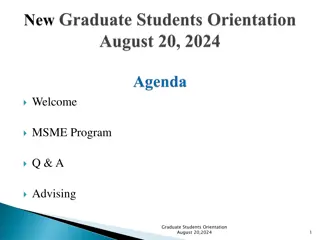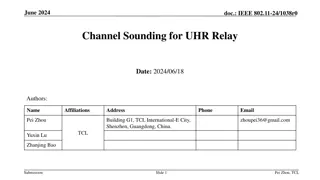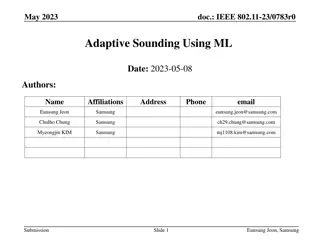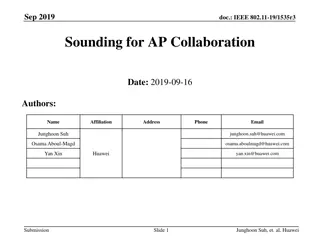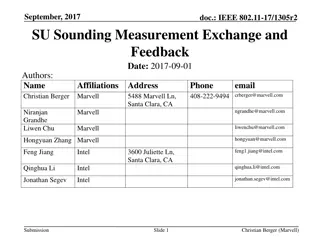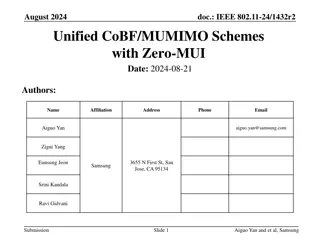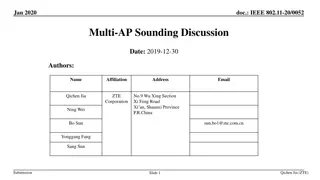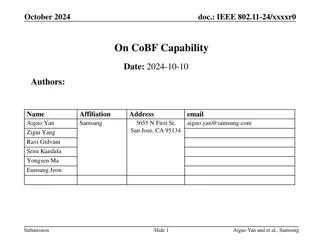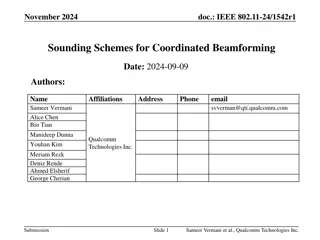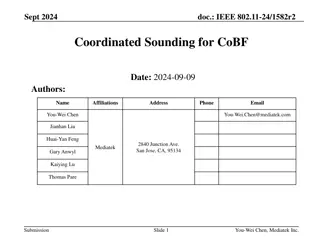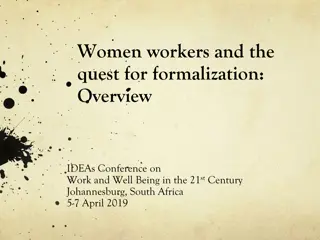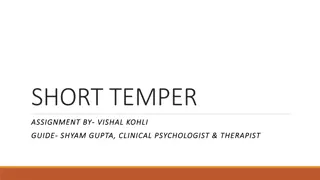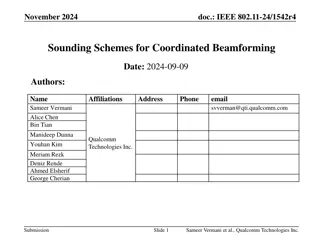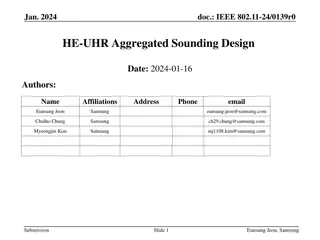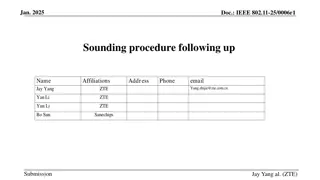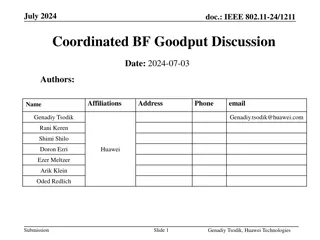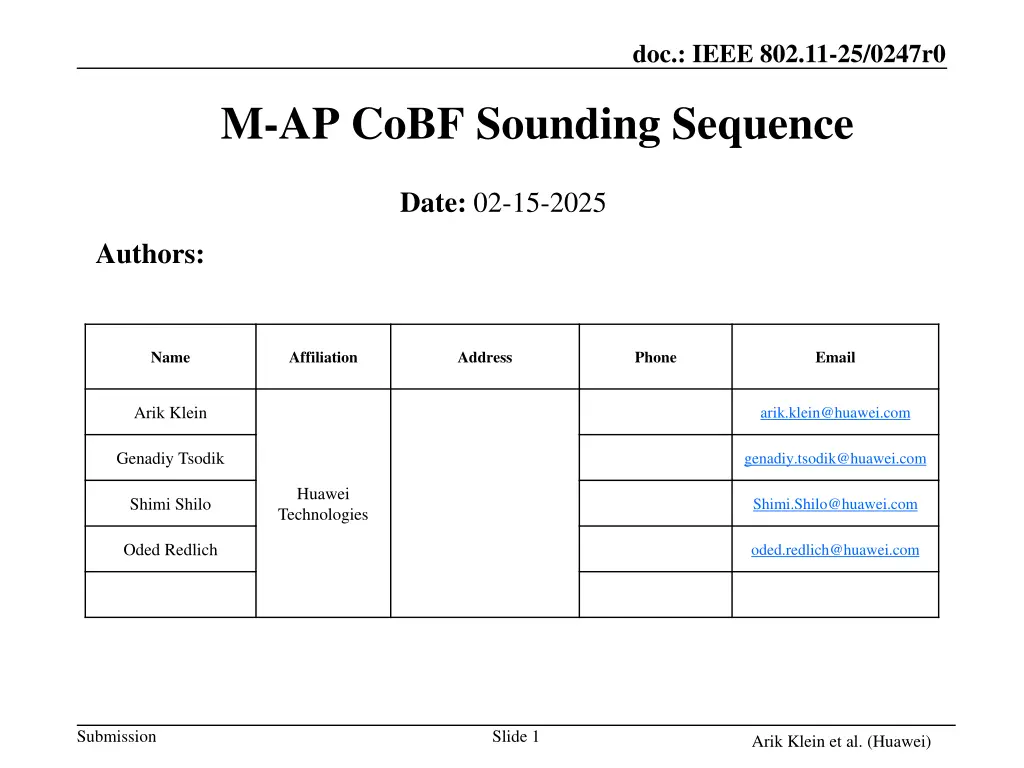
Understanding Challenges in IEEE 802.11-25/0247r0 CoBF Sounding Sequences
Explore the challenges of the proposed CoBF sounding sequences in IEEE 802.11-25/0247r0 document by Huawei Technologies. The presentation discusses the coordination schemes adopted by TGbn, such as Co-SR and Co-BF, along with the variations in CoBF sounding methods. Dive into the sequential and joint CoBF sounding protocols, addressing the complexities and considerations for successful transmissions between STAs and APs.
Download Presentation

Please find below an Image/Link to download the presentation.
The content on the website is provided AS IS for your information and personal use only. It may not be sold, licensed, or shared on other websites without obtaining consent from the author. If you encounter any issues during the download, it is possible that the publisher has removed the file from their server.
You are allowed to download the files provided on this website for personal or commercial use, subject to the condition that they are used lawfully. All files are the property of their respective owners.
The content on the website is provided AS IS for your information and personal use only. It may not be sold, licensed, or shared on other websites without obtaining consent from the author.
E N D
Presentation Transcript
doc.: IEEE 802.11-25/0247r0 M-AP CoBF Sounding Sequence Date: 02-15-2025 Authors: Name Affiliation Address Phone Email Arik Klein arik.klein@huawei.com Genadiy Tsodik genadiy.tsodik@huawei.com Huawei Technologies Shimi Shilo Shimi.Shilo@huawei.com Oded Redlich oded.redlich@huawei.com Submission Slide 1 Arik Klein et al. (Huawei)
doc.: IEEE 802.11-25/0247r0 Introduction TGbn has agreed to adopt the following coordination schemes: Co-SR (TXOP-based with power control) and Co-BF (TGbn SFD, Motion #29) In addition, for M-AP Co-BF transmission, TGbn has agreed to support 2 variants of preceding CoBF Sounding methods: Sequential CoBF Sounding Joint CoBF Sounding This presentation revisits the challenges of the proposed sequences for the CoBF Sounding. Submission Slide 2 Arik Klein et al. (Huawei)
doc.: IEEE 802.11-25/0247r0 Background According to TGbn SFD [1]: The sequential NDP based sounding protocol will be as shown below for Co-BF Sounding happens one BSS at a time NDPA only addresses the in-BSS STAs MAC related additional frames are TBD BF RP NDPA BF RP NDPA AP1 BF RP BF RP NDPA NDPA AP2 STA1 associated with AP1 CSI CSI STA2 associated with AP2 CSI CSI Motion #100 Submission Slide 3 Arik Klein et al. (Huawei)
doc.: IEEE 802.11-25/0247r0 Background According to TGbn SFD [1]: The joint NDP based sounding protocol will be as shown below for Co-BF Sounding happens for one BSS s STAs at a time NDPA only addresses the in-BSS STAs MAC related additional frames are TBD Joint NDP based feedback will be based on large V-based feedback where the eigen-vectors span the antennas across both APs AP1 BF RP NDPA NDPA BF RP AP2 STA1 associated with AP1 arge ased feed a STA2 associated with AP2 arge ased feed a Motion #101 Submission Slide 4 Arik Klein et al. (Huawei)
doc.: IEEE 802.11-25/0247r0 Challenges in proposed sequences (1) The proposed sounding sequence is based on the concept that participating STAs will exchange frames only with their associated AP. BF RP NDPA BF RP NDPA AP1 Following this concept leads to: BF RP BF RP NDPA NDPA 1 2 AP2 2-in-a- ox / ing- ong sequen e STA1 associated with AP1 CSI CSI The ross-BSS part of the proposed sequential sounding sequence involves the subsequent transmission of 2 PPDUs by 2APs (within SIFS!), that have to arefully listen to ea h other: STA2 associated with AP2 CSI CSI (1) The transmission of the Sounding NDP by AP2 is pending on the correct reception of preceding NDPA (transmitted by AP1) (2) The transmission of the BFRP TF by AP1 is pending on the correct reception of the Sounding NDP (transmitted by AP2) This portion is prone to failures and unexpe ted ehavior of the non-AP STAs in case where an AP has not correctly received the end of the previous PPDU (transmitted by the other AP), as also mentioned in [2] a of one oC A that is responsi le for the entire portion of the sequence leads to unstable solution which is hard to debug (in case it is not working as expected). Submission Slide 5 Arik Klein et al. (Huawei)
doc.: IEEE 802.11-25/0247r0 Challenges in proposed sequences (1) Following this concept leads to: CSI feedback corresponding to OBSS AP BF RP NDPA BF RP NDPA The CSI feedback transmitted by STA1 is intended to AP2 (though it is transmitted to AP1) AP1 BF RP BF RP NDPA NDPA AP2 It is clear, that the following that the transmission of the CoBF PPDU an t start if the CSI feedback will not be received by the OBSS AP (AP2). STA1 associated with AP1 CSI CSI STA2 associated with AP2 CSI CSI However, the proposed sequence does not provide any further details on how the CSI feedback (corresponding to the OBSS AP) is conveyed to the OBSS AP? 2 options may be assumed for this gap: Relay from Sharing AP to OBSS AP Hidden re eption of OBSS AP Submission Slide 6 Arik Klein et al. (Huawei)
doc.: IEEE 802.11-25/0247r0 Challenges in proposed sequences (1) Following this concept leads to: CSI feedback corresponding to OBSS AP Option 1 Relay between APs BF RP NDPA BF RP NDPA AP1 Lack of indication in CSI that it is destined for OBSS AP BF RP BF RP NDPA NDPA AP2 STA1 associated with AP1 CSI CSI Need to add transmission between AP1 to AP2 (including acknowledgement on reception) additional overhead to the prolonged sequential sequence. STA2 associated with AP2 CSI CSI Option 2 - Hidden re eption of OBSS A Overhearing problem This option assumes that OBSS AP is required to parse both BFRP TF (all per-STA Info) and CSI (that is individually addressed to AP1) that are not destined to it leads to re eption of any BFR and CSI that are transmitted y the sharing A . Requires to add a verifi ation me hanism (with detailed feed a ) for ea h ase of Cross-BSS sounding for verifying that OBSS has correctly received all the required feedback it needs for CoBF PPDU transmission. In case of failure in reception (BSRP/CSI of OBSS non-AP STAs) by the OBSS AP (AP2), it will require a repeated but redundant feedback reception by the Initiating AP (AP1) - Inefficient mechanism and unnecessary overload of AP1. Submission Slide 7 Arik Klein et al. (Huawei)
doc.: IEEE 802.11-25/0247r0 Challenges in proposed sequences (2) Initiation of Sequential sounding by OBSS AP2 BF RP NDPA BF RP NDPA AP1 BF RP BF RP NDPA NDPA AP2 The TXOP is obtained by AP1 (sharing A ), thus OBSS A 2 an t simply initiate transmission at its discretion STA1 associated with AP1 CSI CSI STA2 associated with AP2 CSI CSI Need to Add trigger frame that will initiate the sequential sounding portion that is performed by OBSS AP2 Need to add indication (for the sharing AP) when the Sounding procedure performed by OBSS AP2 is successfully completed. Submission Slide 8 Arik Klein et al. (Huawei)
doc.: IEEE 802.11-25/0247r0 Complete current CoBF Sequential Sounding sequence - example Time Consuming for each pair of APs Considerable overhead due to basic concept Assuming relay option implemented between AP1 and AP2 Submission Slide 9 Arik Klein et al. (Huawei)
doc.: IEEE 802.11-25/0247r0 Complete current CoBF Joint Sounding sequence - example Considerable overhead due to basic concept Assuming relay option implemented between AP1 and AP2 Submission Slide 10 Arik Klein et al. (Huawei)
doc.: IEEE 802.11-25/0247r0 Summary This contribution discusses the challenges in the current proposed CoBF Sounding sequences 2-in-a- ox / ing- ong sequen e CSI feedback corresponding to OBSS AP Initiation of Sequential sounding by OBSS AP Need further discussions on the proposed resolutions for the detailed challenges. Submission Slide 11 Arik Klein et al. (Huawei)
doc.: IEEE 802.11-25/0247r0 References [1] 11-24-0209-06-00bn-Specification Framework for TGbn [2] 11-25-0006-02-00bn-sounding-procedure-follow-up Submission Slide 12 Arik Klein et al. (Huawei)

